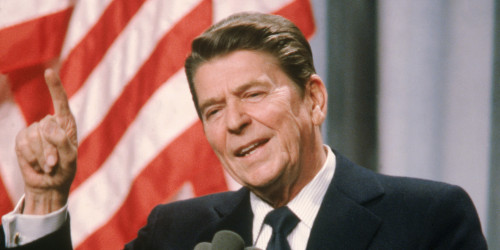Why is "The Reagan Years" about the Reagan Years?
Some notes about how I decided to restrict (for the moment) the scope of my game to the point of view of USA in the 1980′s.

Historical data VS historical process
In his book about Balance of Power, Chris Crawford states that “data is not the main element in realism - process is. […] The actual amount of GNP of Ghana is less important, for the purposes of a game on geopolitics, than the manner in which GNP changes with time”. Crawford’s game is all about depicting the global mechanics of superpower competition in the cold war era. He mainly intends to make a point about the dangers of warmongering, taking a pacifist stance that he feels is needed in the context of the 80′s.
The opposition drawn by Crawford between data (historical facts at time T) and processes (dynamics applied to this data) is problematic when we come to terms with its practical applications in game design. Since he is not aware of the imminence of the USSR collapse, Crawford sets up a game running from 1985 (the then-present time) to 1997. He makes the statement that “the principles [of geopolitical interaction] have not changed fundamentally since the introduction of the nuclear-tipped ICBM”. This also leads him to claim that his game system could relevantly depict former periods of the cold war, for example the 60′s. According to him, to do this, only the data would need to be adapted, while the game’s processes would stay relevant.
Cautiously restricting my game’s historical scope
When I started developing Reagan Years, I intended to create a modern version of Balance of Power, introducing only minor changes in the game’s data and in the user interface. I immediately realized that the historical scope of the game would need to be redefined. It would be odd for a modern game to depict a USA-vs-USSR competition running till 1997. I therefore started to consider other relevant periods of the cold war. However, going through this preliminary process of selection has led me to question Crawford’s assumptions on the permanence of geopolitical principles through the entire 1945-1990 period.
Here are some of the questions I ask myself at this stage: isn’t Balance Of Power a reflection on the USA international policies during the 80′s, rather than a depiction of global dynamics for a near-50 years period ? Is it historically relevant to consider that USA and USSR geopolitical points of view were symetrically opposed, like those of two chess players? Had this game been designed in USSR during the 80′s, what kind of global dynamics would it have depicted? And if today’s mainstream depictions of this era are all about USSR-USA competition, is it because the accuracy of such a model, or merely because history is written by powerful dominant powers?
It will take a lot of research and thinking before I finally adopt a satisfying stance on these questions and find a way to reflect this stance in my game’s design. Meanwhile, it seems safer to restrict the scope on which the historical principles of my game apply. Therefore, I have decided that the game will only depict the years of Ronald Reagan presidency (1981-1989), and that it will only depict the point of view of the USA. This will apply until I have the safe feeling that my game’s dynamics can relevantly apply to other countries and eras.





